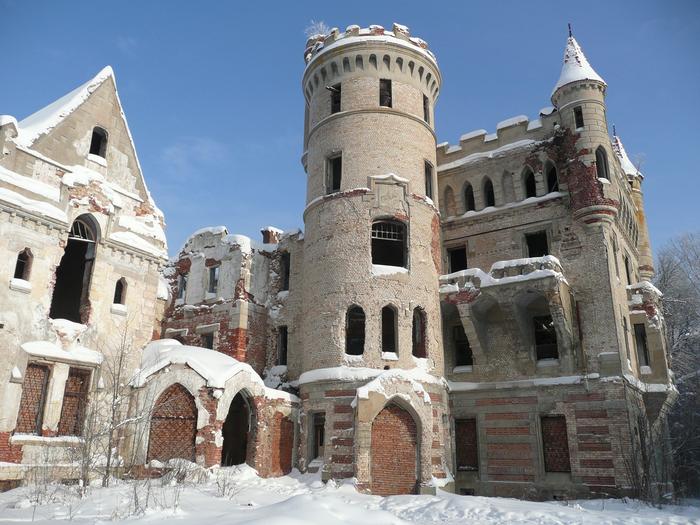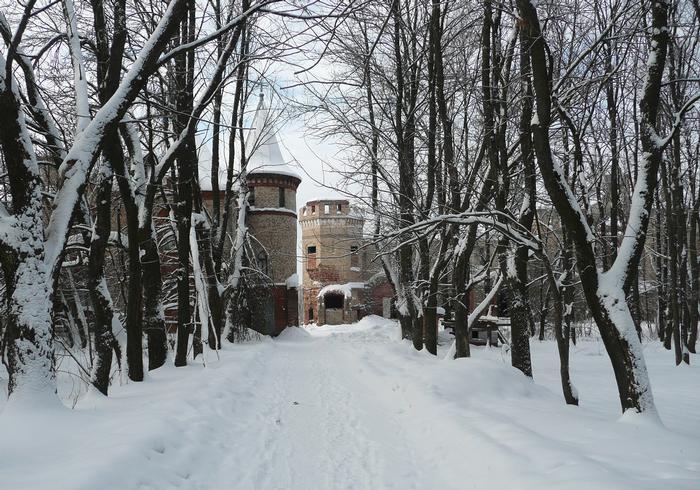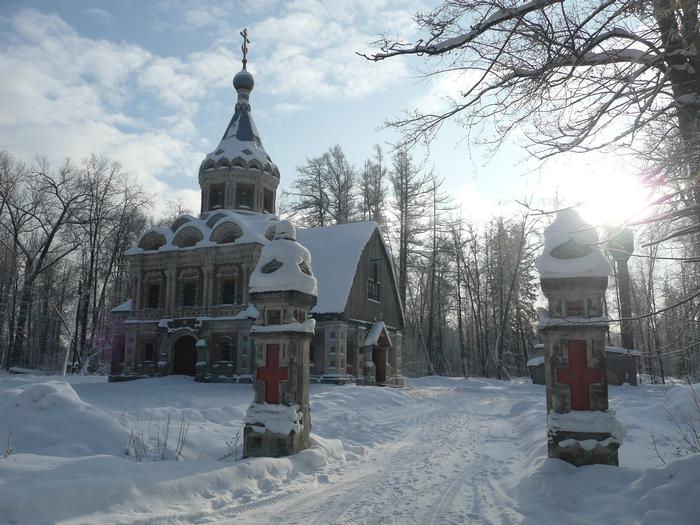[ID:70] Sacred Spirit of RuinsRussian Federation There are no inherently sacred objects, events, or thoughts; they are made sacred by a special context. (Lynda Sexson, “Ordinarily sacred”)
A man tends to weave meanings into things, environment and space. It gives him some reference points to identify himself in this space, it allows him to categorize it in some way, contextualize his behavior, focus his attitude and lets him be a part of this environment. So the sacred space is endowed with spiritual sense, where materiality is less important than immateriality. This space opposes the mundane, trivial, profane and it borders the aesthetics of myth. It is the space where one gets a peculiar spatial feeling experience, or experience of “otherness” [1], a chance to stay along or stay in the other reality, finds shelter from the routine, asks himself questions. He gets an opportunity for spiritual search, though it might not necessarily be associated with religion senses. “The sacred, when not bound up by politics and economics, is nearer to something we call the aesthetic” [2] and that constitutes the essence of the sacred category, addressing directly to man, or, to be more precise, to his senses and feelings: nonverbal component. Although there are basic, structural characteristics of the sacred space, it tends to be strongly personal and every man has his own definition of sacred, based on human culture and his individual experience.
I find the sacred in ruins, those buildings and structures that once were built but became abandoned by man to the influence of time and nature. Those lonely urban orphans become really beautiful by its dilapidation and transform into unique art objects. In this context, ruins appeal much more as they are than their original shape. And a ruin potentially is always an adventure: a man could easily get lost there; find some strange old things, secret rooms. Being overgrown by moss, covered by leaves or snow, ruins charm by mystery, hiding answers to our questions. Since we will never get them, they impose themselves more upon one’s feelings and aesthetic perception. An independent aesthetic essence of ruin space arises here with the beauty of intrusion of nature into that abandoned man-produced structure. And this ruin space category exists above time, form and function.
The function initially intended to this place is now lost. A living room is no longer the place where the family gathers in the evening near the fireplace, nobody serves lunches in the dining room any more, and no one meets guests in the hall. The structural elements also neglected their function: the staircase doesn’t connect any more the upper floor with the attic, because there is no floor between them now; beams no longer endure the ceiling load because slabs crashed, and the remains of the roof do not protect from snow or rain. With this loss of function, the form becomes free. The original shape physically ceases its original form and sometimes only exists to the onlooker as a ruin, because he might not be able to see the former building. Even if historical photographs, documents, plans and drawings are available, they wouldn’t give the whole picture that includes sensitive perception of form and space. Ruins offer a mind game to the onlooker, suggest him to choose a scenario for experiencing the space, and tell him about different ways to discover the space. These might not have existed before and even oppose the original architectural plan, but are possibilities now. Everything here is opened to interpretation: materials, surface finish, structure. Their aesthetic effect is one of the most important values of ruins. It might be brick falling out at some places with stamp or production dates, or it might be cold and grey concrete, even glazed tiles facing the fireplace in the early times, pieces of wooden floor or crashed roof tiles.
Now former buildings and structures move to a new stage of existence: between materiality and immateriality, between tangible and sensitive, above time, function and form. Physical shape collapses and instead its meaning takes place so that man could only feel or sense: mentally, he is able to fill the whole image and reach the “otherness”. Consequently, a special context of environment, history, culture and memory converts ruins to sacred space. Once a visitor gets there he stays along with an unknown and even unpredictable space that makes him dream, think, orientate, compare things, or search for the new; all the things he doesn’t usually have to do in the comfortable living urban space, conceived for his convenience. The ruins liberate a person from the routine and life scenario and let him listen to himself.
Certainly many things depend upon man, upon a community that maybe ready or not to perceive ruins as an aesthetic essence or even more as a sacred space. I believe almost all Russians consider ruins only as a marginal and asocial place, which eventually should be reconstructed to its original building or structure. There is unfortunately just a small amount of good examples of really great work in this way; most lost its history, memory and unique atmosphere of the past forever. The object we are going to analyze is located thirty kilometers away from the city where I live: Muromtzevo town, in the Vladimir region. It is the ruin of a former nobleman estate that was built at the end of nineteenth century by architect Peter Boitzov for Russian nobleman and timber merchant Vladimir Khrapovitzky. It was a large-scale, wide architectural complex built in pseudo-Gothic architecture, related to the time of romanticism, in a non-traditional way for Russia. The main house reminds a mid-century castle, and in front of it there was an Italian garden with a complex water-cascade, regular terraces, and a French garden with many beautiful fountains. And we can still find remains of retaining walls for the cascades and terraces overgrown by moss. A bit lower by the lakes there was a boathouse, and around them fruit gardens, arboretum, greenhouses. The whole year French plums, peaches and other fruits from the gardens were delivered to Moscow and Saint-Petersburg. There were lots of exotic trees such as palm trees and box-trees in the greenhouse that were bed out for the summer. It is hard to imagine the amount of work involved, knowing how rigorous climate we have in the central part of Russia. Among other buildings in the complex there were stables, kennels, a henyard, a lodge, a church, a theater, and some service houses. Some of them are now being used as private dwellings, others fell to ruins. Some of researchers say that the estate had a water supply system, their own telegraph station, telephone and electricity. It was really a great building complex, but as the historians say, the main goal of its owner was to impress the Tsar and his European guests by its beauty, size, and richness.
After the period of revolutions in Russia the main building was nationalized and given to the Forestry Engineering College until 1979, while the Khapovitzky and his family had to immigrate to France. They say, after the owners had gone away, that the swans also left this place. Although the building lost its inhabitants, students and teachers from the College were keeping it in proper condition, but after 1979 they moved to a new building. Since that time the estate had been in the custody of the Federal Government and was granted the status of architectural monument. Unfortunately, for almost thirty years nothing else was done to preserve the building from destruction. From time to time different investors had been leasing it for a while and even made requalification projects, some drawings, plan to open a hotel or holiday center here, but all the projects fell short of completion. Step-by-step the building area becomes smaller (from 40 hectare to 8), the village around grows and occupies the territory around with new private houses. As in the most part of all Russian estates, this one is in a catastrophic situation with all damages made by a ruthless weather and the cruelty of aging. The people who are responsible today for heritage preservation ignore these damages because of lack of interest in the local community towards cultural and historical monuments and its further destiny. It’s hard to find exact information about current leaseholders, their projects and time-frames. Comparing the old pictures of this place and its current condition the level of damage is appalling.
However I would say that the very moment until when the restoration was historically justified has already gone. The building that lost its owners was ransacked, tired of the cruelty of time and events. Then it achieved a new life, history and sense in ruins. There is memory, culture, unique atmosphere here. An atmosphere of mid-century castle exists here as if it suddenly arose in the middle of the Russian forest and contemporary, uninteresting brick and concrete buildings. These ruins, in contrast to new buildings talk to a viewer via uncovered materials and structural elements, nothing is hidden here. But you should try to find its messages by yourself. A man gets unique feelings and senses here, unique spatial experience, because it is like nothing else in his usual environment.
Among the private or public spaces we experience every day as our apartments, houses, offices, lecture halls, or classrooms, the strict master plan, and regular parks there is no place left to any freedom that ruins have. It’s weird to see a crushed building in our usual environment; it both scares and challenges us to discover it, because it looks like nothing else and immediately arouses emotions: positive or negative, but still talks to our sensitivity. On my mind the estate in Muromtzevo found a new special beauty as a ruin, something more than a beauty of new architecture, rich interiors or perfect decoration work. It found something immaterial, intangible, I would say sacred. And that sacred atmosphere is what has to be saved and what matters to be preserved.
Ruin beauty is of a very special kind. Lots of photographers, artists, and architects come here for creative search, historians and culture experts write about this place, and lots of travelers who are just interested in history of Russian estates and architecture come here. These ruins charm us, romanticizing our notion and images of the past, history, noblemen living there, and the effects of time. It creates a visually harmonious and aesthetically holistic view, while the special context of history, environment, culture, and time adds the sacred meaning to ruins. Without these contexts these ruins are perceived only as nothing more than remains of a formerly splendid and now abandoned building. Moreover, I consider that the local community thinks exactly this way, because the context was broken and my suggestion is to try to restore this special ambience to keep the sacred spirit.
And what is going there nowadays is that the buildings and the territory around really became marginal, accumulated litter, in danger of becoming obliterated by dense, overgrown vegetation, without fixed roads or pathways. The main entrance goes through the broken, rusty iron gates that stand there since the soviet times, with a sign announcing that the college is here. The territory is now partly occupied by new private cottages, college building, and some village houses. The main house has been ransacked and everything valuable had been stolen, the walls are covered by graffiti and the constructions are really dangerous for the visitors. And still the architecture is worth of praise: massive round tower, lancet windows, balconies, beautiful hammered details. Not far from the main house still lie the ruins of massive stables, also a very beautiful church, and some other parts of several buildings. I consider the vandalism against these unique monuments to be a clear reflection of the culture of our community and times we live.
One of the most impressive buildings suffered the effects of history and time, falling to ruins. But also gained an unique atmosphere and sacred sense, and in my mind it is of the utmost importance to be able to save exactly this sense, instead of building or reconstructing a new one that wouldn’t have any connections with history and wouldn’t possess that special immaterial sense. It is fundamental to preserve, maintain, what remained of this ruin in order to avoid further demolitions and to try to slow the erosion of time: clean the building from trash and construction fragments, fix the walls and recover the roof. Make it so that these ruins would stay as a picturesque old castle, which nobody knows how and when suddenly appeared here, far from highways, noisy towns and everyday fuss, but at the same time keep safety conditions for visiting. The attitude towards ruins in our local community could be changed when people see that this building fascinates by mysteriousness, romanticism, and freedom and is not dangerous and asocial.
Returning to the historical and cultural contexts, it is important to renew the estates’ park, where visitors could feel themselves as a part of history imagining how people were walking here at the beginning of the twentieth century: fix the park paths, benches, park architecture, greenhouses, and fruit gardens – context that existed before and could raise significantly the touristic quality of the territory. In front of the main House fountain cascades and water terraces that connect those to the big lake could be reactivated, as well as the boathouse on the lake, with just a few boats, but it would enlighten the life of the estate. Some day even the swans would come back. Beautiful views have already been created here by nature and it is man’s work to maintain them.
No museums, no parking lots, no hotels, no restaurants, no SPA, nothing what investors are talking about, nothing that could destroy the sacred sense here, break the time flow, history and memory. This place is far from any touristic routes. It’s impossible to get here accidentally and that is why this place still has its unique atmosphere, originality, and identity and the ruins keep sacred.
1. Otherness (or “Anderssein”, - german ) is the term used by G.W.F. Hegel, The Phenomenology of Spirit
2. Lynda Sexson, “Ordinarily sacred”, The University Press of Virginia, 1992, p.3
If you would like to contact this author, please send a request to info@berkeleyprize.org. |




